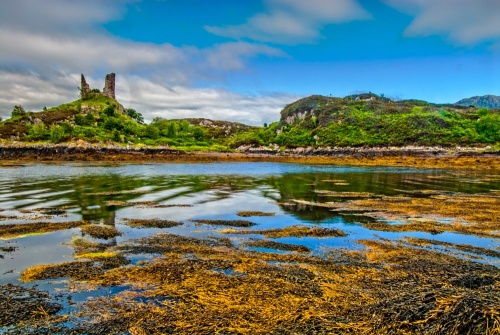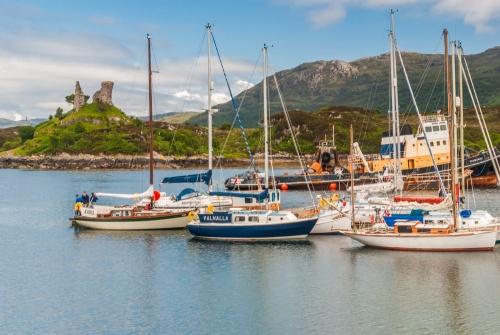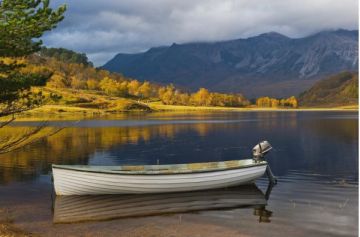
Castle Moil (also known as Caisteal Maol, Castle Moll, and Castle Maol) is a ruined 15th-century castle on a hill overlooking the entrance to Kyleakin harbour on the Isle of Skye, opposite Kyle of Lochalsh. The roofless ruin we see today dates to the late medieval period, but it seems highly likely that an earlier castle stood on the same site.
History
The origins of Castle Moil are a mix of history and legend, and it is hard to know where one ends and the other begins.
Castle Moil was probably built by the Norse during the 9th century, as part of their attempt to control the coast of western Scotland. The Norse would have used the sheltered harbour at Kyleakin to anchor their longboats, and the castle served to command the strait of Kyle Akin that separates Skye from the Scottish mainland.
Ships sailing up and down the coast had to pass through the strait, or attempt the dangerous passage of The Minch, between Skye and the Western Isles.
According to one version of the tale, Findanus of Mull, Chief of Clan Mackinnon, married a Norwegian princess, known to history as 'Saucy Mary', whose dowry lands included Caisteal Maol. This brought the area into Mackinnon hands, and Castle Moil was a regional seat of Clan Mackinnon until the 14th century when the Lairds of Mackinnon moved to Strathardill, also on Skye.

The Toll Chain
Tradition also suggests that Castle Moil was a source of revenue for the clan, after Findanus and his bride had a chain stretched between the castle and the mainland. Ships wanting to pass through the strait had to pay a toll, or make their way around Skye and attempt the passage of The Minch, known for its treacherous storms.
By tradition, King Haakon of Norway used Castle Moil as the assembly point for his fleet prior to the pivotal Battle of Largs in 1263. Indeed, the name Kyleakin means 'Haakon's kyle'. Medieval records also refer to Castle Moil as Dunakin, from 'Dun Haakon'.
Clan Mackinnon controlled Castle Moil throughout the medieval period. It was they who rebuilt the fortress, sometime during the reign of James IV (between 1488 and 1513). This version of the castle was a fortified tower house on a rectangular plan, standing perhaps three storeys high and surrounded by service buildings.
In 1513, Castle Moil was the site of a clan meeting where the chiefs decided to support Donald MacDonald as Lord of the Isles.
Castle Moil was abandoned following the death of Neil Mackinnon, nephew of the clan's 26th chieftain, in 1601. By that time, the medieval castle was too old and uncomfortable to serve as a residence. Even after they abandoned the castle, however, the Mackinnons continued to benefit from their ownership of the Kyleakin estate, since they were granted a monopoly over ferries crossing the strait.
The castle we can see today is a roofless ruin, badly decayed, with walls crumbling and the ground floor filled in with rubble. The most recent blow to the castle came in 2018 when it was struck by lightning, destroying the top section of one wall.
Getting There
The castle stands on a headland at the south-eastern extremity of Kyleakin. From the main visitor parking area on the north side of the harbour, take South Obbe Road and walk across the bridge to the south side of the harbour. Follow the road to the end and you will see a footpath leading off to the right.
From here you can access the shore, with wonderful views of Castle Moil across a small inlet. Just follow the trail as it winds along the shore to the castle. At low tide it is easy to reach the castle, but at high tide you'll have to scramble over rough terrain to avoid underwater sections of the trail.
Be careful! Though the castle ruins have been recently stabilised, you explore the site at your own risk!
If you don't fancy the walk to the castle you can still get excellent views from the north side of the harbour.
About Castle Moil (Caisteal Maol)
Address: off South Obbe Road,
Kyleakin,
Isle of Skye,
Highlands and Islands,
Scotland
Attraction Type: Castle
Location: Reached by a footpath off the eastern end of South Obbe Road, on the south side of Kyleakin harbour.
Location map
OS: NG758263
Photo Credit: David Ross and Britain Express
HERITAGE
 We've 'tagged' this attraction information to help you find related historic attractions and learn more about major time periods mentioned.
We've 'tagged' this attraction information to help you find related historic attractions and learn more about major time periods mentioned.
Find other attractions tagged with:
NEARBY HISTORIC ATTRACTIONS
Heritage Rated from 1- 5 (low to exceptional) on historic interest
Balmacara Estate and Lochalsh Woodland Garden - 2.6 miles (Garden) ![]()
Totaig Broch - 6.8 miles (Prehistoric Site) ![]()
Dun Telve Broch - 7.2 miles (Prehistoric Site) ![]()
Dun Troddan Broch - 7.4 miles (Prehistoric Site) ![]()
Eilean Donan Castle - 7.7 miles (Castle) ![]()
Strome Castle - 8.6 miles (Castle) ![]()
Cill Chriosd (Kilchrist Church) - 9.5 miles (Historic Church) ![]()
Bealach na Ba (Pass of the Cattle) - 9.5 miles (Countryside) ![]()
Nearest Holiday Cottages to Castle Moil (Caisteal Maol):
Nearby accommodation is calculated 'as the crow flies' from Castle Moil (Caisteal Maol). 'Nearest' may involve a long drive up and down glens or, if you are near the coast, may include a ferry ride! Please check the property map to make sure the location is right for you.
Kyle of Lochalsh, Highlands and Islands
Sleeps: 4
Stay from: £428 - 2255
Kyle of Lochalsh, Highlands and Islands
Sleeps: 2
Stay from: £347 - 1808
Kyle of Lochalsh, Highlands and Islands
Sleeps: 4
Stay from: £814 - 3718
More self catering near Castle Moil (Caisteal Maol)




